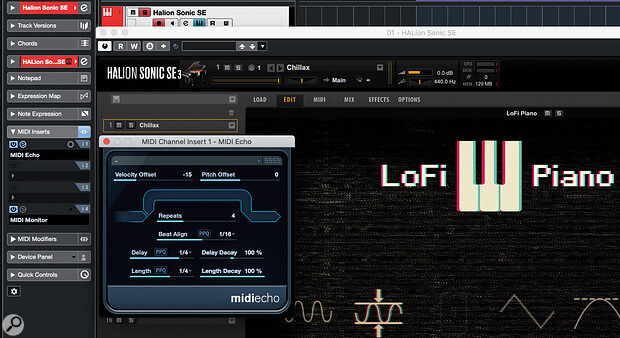 Screen 1: The MIDI Echo plug‑in is an alternative approach to creating delay/echo type effects with your MIDI instruments.
Screen 1: The MIDI Echo plug‑in is an alternative approach to creating delay/echo type effects with your MIDI instruments.
Cubase's stock MIDI plug‑in collection includes some unsung heroes...
New musical ideas aren’t always easy to come by and, while Cubase has all sorts of ‘muse assistance’ tools built in, its rather humble‑looking collection of MIDI plug‑ins can often be all you need to get the creative juices flowing. Both the Pro and Artist versions of Cubase (sorry Elements users!) include a suite of 18 MIDI plug‑ins, and I’ve touched upon a number of these plug‑ins individually in previous columns — for example, I used Arpache SX in SOS December 2020: www.soundonsound.com/techniques/cubase-string-theory-part-2. But as each MIDI/Instrument track has four MIDI insert slots you can use them in combination, and this month I’ll explore how you might do that to provide the creative spark for a new song or composition.
Repeat After Me
The MIDI Echo plug‑in provides a somewhat different approach to the concept of delay/echo than the more commonly used audio‑based delay effects: rather than operate on an instrument’s audio output, It repeats the MIDI notes that are fed into it. In Screen 1, I’ve inserted MIDI Echo into the first MIDI insert slot of an Instrument Track, with a Halion Sonic SE piano sound from the free (and super‑cool) LoFi Piano expansion pack loaded.
 Screen 2: The MIDI Monitor plug‑in provides very useful visual feedback when processing your MIDI data.
Screen 2: The MIDI Monitor plug‑in provides very useful visual feedback when processing your MIDI data.
Note that I’ve also inserted an instance of the MIDI Monitor plug‑in in the final insert slot (see Screen 2), and if you leave this one open as you experiment, you’ll see a live stream of the MIDI data being generated by the MIDI Echo plug‑in. Obviously, you need first and foremost to listen when making changes, but a visual display can be very useful if the adjustments you make aren’t delivering the results you intend.
MIDI Echo’s controls can be used to create simple delay effects, as illustrated by the screenshot settings. The Repeats setting is configured to generate four repetitions of any note played (by default, the first occurs with the actual input note itself), while the negative Velocity Offset value means that the MIDI velocity (and therefore volume) is gradually reduced for each repeat.
The Delay parameter, set here to simple quarter‑note values, determines the delay time: play a note or simple chord, and it will repeat four times, each with gradually lower volume, and with the delay time locked to the project tempo. With various options for different time bases (with dotted and triplet settings) as well as PPQ (effectively giving you a time‑based adjustment if you don’t want the delay locked to the project tempo), you can easily add to the rhythmic interest it creates....
No comments:
Post a Comment